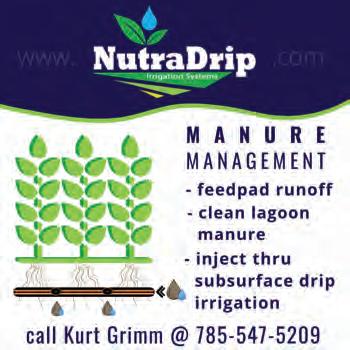
5 minute read
Variability is the rule
Recognizing the changing characteristics of manure can help make the most of this valuable resource.
by Scott Fleming
Advertisement
While it all fits under the loose term of “manure,” if you’re reading this, you well know that all manure is not the same. And while we can categorize it by source, that doesn’t remove the variability that exists across its many facets.
Manure has gained a “difficult-to-manage” reputation as fertilizer, but it doesn’t have to be. With systematic manure analysis and an understanding of all contributing factors, its variability can be identified and this resource turned into a valuable fertilizer.
A look at phosphorus
Phosphorus is generally the most regulated component in manure. This is due to the risk of phosphorous delivery to surface water. When phosphorus runoff travels to surface water it can cause excessive algae growth.
The great news about phosphorus management is that this element tends to stay put in the environment. Soil erosion and manure runoff are the most likely culprits leading to phosphorus runoff. There is also a soluble phosphorus component to manure, but it is minor. With sound tillage and rotation practices, as well as effective incorporation, the risk of phosphorus runoff can be minimized.
Phosphorus content in manure tends to vary slightly during manure application. High phosphorus concentrations are commonly associated with manure that is high in solids content. This is especially true in a multistage manure storage structure.
At a minimum, a manure sample should be pulled at the start and finish of each stage. A more comprehensive approach would include additional sampling when manure consistency changes. The only way to identify this variability is through a thorough sampling program.
Working with nitrogen
Nitrogen may be the single largest reason growers are applying manure. It is a great source of fertilizer for next year’s nitrogen-demanding crop. Nitrogen is also one of the toughest nutrients to control when it comes to applying manure. Nitrogen in manure can vary from the beginning of application until the last hose is on the reel.
To further complicate management, nitrogen is very mobile in the soil profile.
If a warm or wet fall is in store, nitrogen could be lost through the bottom of the system due to leaching. The same problem can occur in a warm or wet spring.
To help manage loss of fall-applied manure to the environment, it is best to apply manure when soil temperatures are below 50°F. If application cannot be delayed, many nitrogen stabilizer products are available.
Nitrogen can also be lost to the atmosphere thanks to volatilization. This can be controlled by the manure application method as well as nitrogen stabilizer products.
The hard and fast rule to limit volatilization is simple: The faster the manure gets mixed with the soil, the more nitrogen you will have for your crop. Limiting manure’s exposure to the air reduces its potential for volatilization.
Injection is the best way to maximize the amount of nitrogen available, followed by prompt incorporation. Surface application comes in at a distant third. This is an effect of the loss of nitrogen to the atmosphere when it lays on the soil surface. These losses to volatilization occur from the moment manure is applied to the field. Obviously, minimizing these losses can prove beneficial to the environment and the bottom line. The Wisconsin nitrogen calculation method is fairly straightforward, so it’s easy to utilize in an example. When direct-injecting liquid dairy or beef manure, 50% of the total nitrogen is available in the first year. If the manure is surface applied and incorporated within 72 hours, 40% of the total nitrogen is available to the crop.
If the manure is not incorporated within 72 hours, only 30% of the manure’s total nitrogen will be available for the crop. The remainder of the nitrogen in each of these scenarios is either lost to volatilization, or it is slow-release nitrogen and will become available in the second and third year after application.
It is also important to note that different sources of manure have different first-year nitrogen availability. For example, swine manure has 65%, 50%, and 40% first-year availability when injected, incorporated, or surface applied, respectively. Check resources from your state for more specific information about nutrient availability.
Supplier Forum
In addition to source and application method variation, there is also variation of manure from farm to farm. Some likely causes for this variation include diet, precipitation, manure handling and transfer method, and animal size and type. To further complicate matters, the manure within a storage structure will vary enough to merit additional analysis. To account for this variability, manure analysis must be performed on a regular basis throughout the application season.
Sampling for consistency
As discussed earlier, much of the variation in manure tends to follow the concentration of solids. For a permitted livestock operation, a minimum of one composite sample per source is required for each application period. In a multistage manure system, this would mean one sample per stage. Additional manure samples should be pulled for all solid or composted manure.
This is the bare minimum sampling strategy that should be employed. Ideally, pull additional samples after major changes in manure consistency, prolonged application delays, and on each manure transfer field.
When looking at the impressive fertilizer value of manure, it is best to take sampling more seriously than meeting the minimum requirements. After all, you could pay for more than 10 manure samples by saving just 1 ton of urea.
While the relative cost of manure analysis may be low in comparison to fertilizer, managing the sampling strategy is still necessary to provide useful data. If too many manure samples are pulled, the data could become overwhelming and would likely not drive additional management changes.
A strategy commonly employed is sampling when switching fields. This will allow the producer the opportunity to tailor commercial applications to the exact manure credit for that field. Another important time to sample would be following a shutdown. The manure composition could change and this may cause variability.

If manure is applied to land that is not under the control of the farm applying the manure, this is a great opportunity to pull a sample. It provides peace of mind and helps show value for the manure application.

Manure sampling strategies are almost as variable as manure itself. Creating a game plan prior to application season will help direct sampling efforts and improve efficiency. Start pulling manure samples with purpose and putting them to use, and reap the value of this readily available resource. ■
• Liquid Manure Handling

• Solid Manure Handling
• Trucking
• Pushing & Packing
Digital Nutrient Reporting From Livestock Water Recycling

Livestock Water Recycling’s patented fertilizer PLANT system maximizes manure revenues by digitizing nutrients, biogas, and carbon while reducing the expense and environmental impact of these dilute liquids. This digitization is made possible through an award-winning automation and data analytics package that retrieves information from on-system sensors to create actionable insights for all types of food producers.
The mobile application myPLANT offers real time, automatic, up to the minute data reporting for access to nutrient, carbon, and renewable natural gas markets to make the most money from your manure. From easy access to digital marketplaces for fertilizers and biogas, managing nutrients for trading, or regulatory reporting for greenhouse gas and carbon credits, the LWR PLANT and the myPLANT mobile application are the crucial next steps in the monetary maximization of manure. Learn more at www.livestockwaterrecycling.com.

Gea Introduces A New Scraper Cable Drive
Make the most of your available space with GEA’s enhanced elevated stand for the SW cable drive unit. Mounting an SW series cable drive unit over a cross gutter means less clean up and easier maintenance. This option is available for new and existing drive units.
There’s another new addition to the GEA ProManure lineup, too. It is a tilting blade rubber shoe for alley scrapers. This new rubber shoe is more resistant to wear caused by sand in the alleys.
GEA offers a full range of drive units to simplify your life and give you more freedom for the installation location. Learn more about GEA ProManure at gea.com/dairyfarming.







